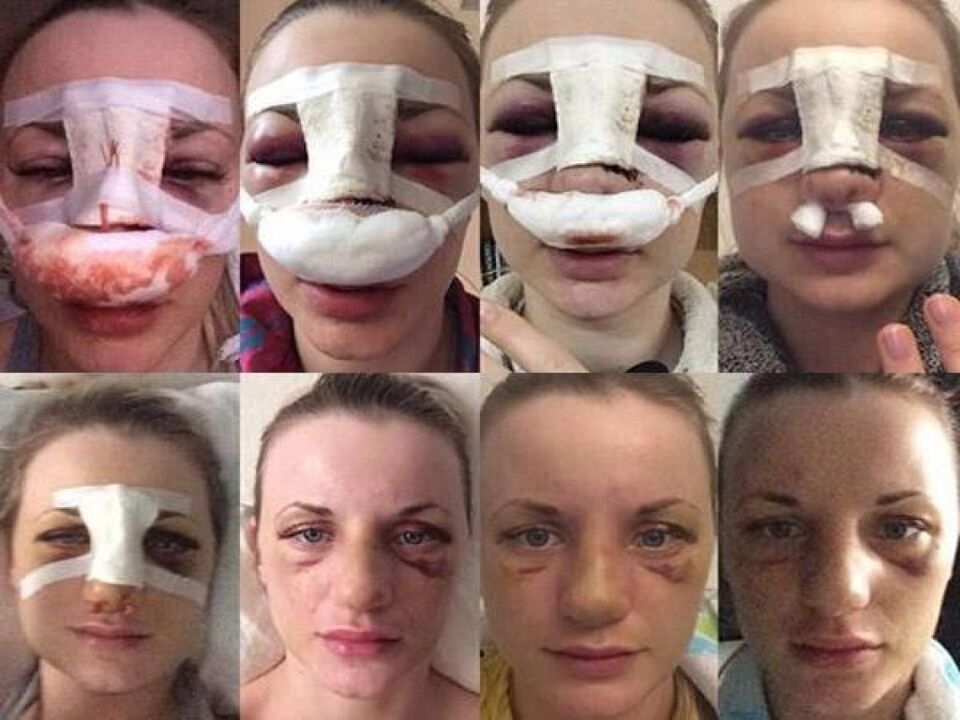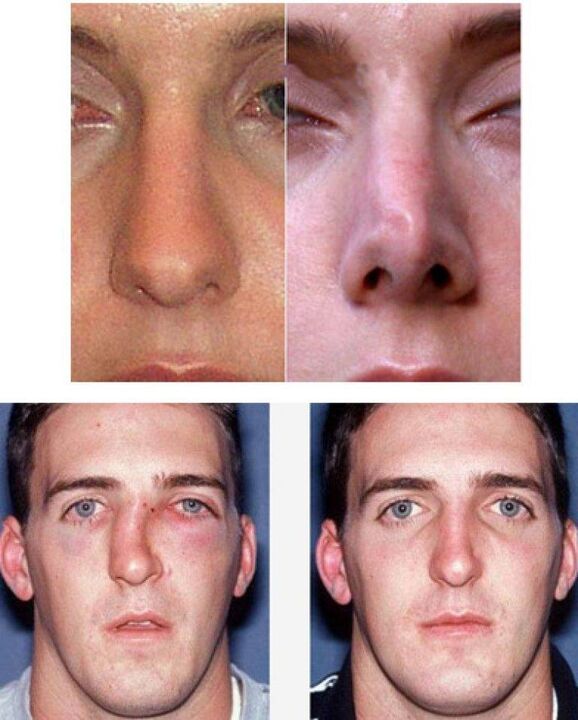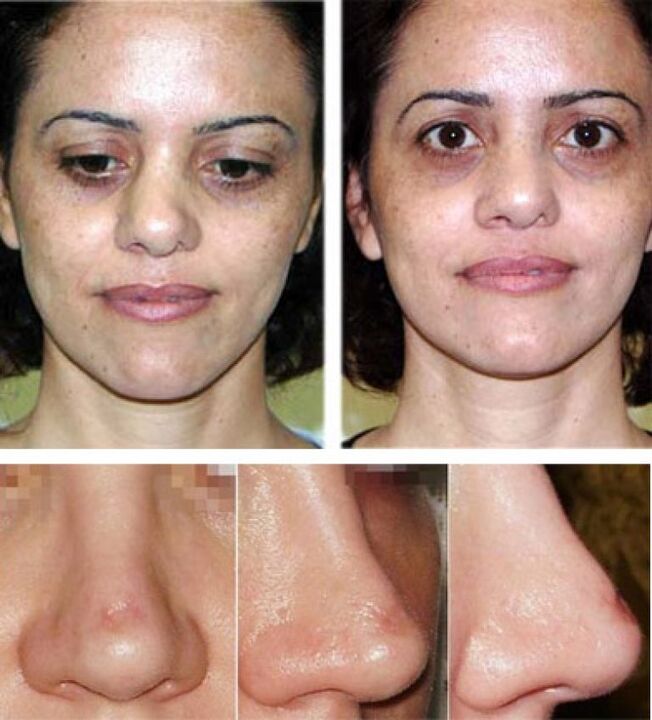Rhinoplasty is considered a major surgical procedure. Too often, the result obtained after rhinoplasty does not always turn out the one we would like. And that already requires a second operation. Rhinoplasty will be considered unsuccessful if it has not brought the desired effect or has aggravated the patient's condition. Must be treated very responsibly. With a wrong correction of the shape of the nose, loss of smell, curvature of the septum and difficulty in the process of breathing, excessive swelling can be achieved. Therefore, before rhinoplasty, you should be aware that the result may differ from the desired one.

Possible complications
Sadly, it is quite difficult to predict how rehabilitation will occur. Even the most experienced doctor will not be able to tell exactly what the body's reaction will be. Therefore, it is believed that plastic is a piece of jewelry, and rhinoplasty is filigree. The consequences after surgery can be irreversible and in preparation for such an intervention, all potential risks must be reasonably assessed.
The most likely side effects of rhinoplasty are:
- nosebleeds;
- hyperpigmentation at the site of exposure;
- disorders of lymphatic and blood flow, leading to the formation of edema and hematomas;
- abscess;
- hemorrhages in the operated and adjacent areas;
- complete or partial loss of smell;
- difficulty breathing as a result of swelling of the mucous membranes;
- curvature of the nasal septum;
- excessive formation of scar tissue, which ensures the formation of a voluminous scar;
- inflammatory process in soft tissues.
The appearance of the above signs characterizes an unsuccessful operation.
Causes of complications
Knowing the possible causes of complications after plastic surgery, their prevention is much easier and safer for the body.
Lack of experience
The most common prerequisite for side effects from rhinoplasty is the low qualification of the surgeon. Insufficient experience pushes the doctor to ignore some mandatory points. In addition, the impact of small practical skills development is possible. They are especially important in rhinoplasty. The nose has a very complex structure and the smaller the mistake, every wrong move can have irreversible consequences.
Wrong choice of technique
An inexperienced doctor may not necessarily be wrong. Experienced surgeons also make mistakes and this happens much more often than we would like. This is due to the fact that there are several techniques for rhinoplasty. Each of them is more optimal for use in patients with certain anatomical features in accordance with the desired purposes. Wrong choice of technique for nasal plastic surgery can also bring serious results, which in most cases can not be eliminated.
Disorders in postoperative care
A successful plastic surgery is only half the positive result. The second part belongs to the recovery period. It will be the patient's behavior at this point that will be of great importance. Failure to follow medical recommendations leads to the appearance of edema, hematomas and active scarring of tissues. A doctor who does plastic surgery in general can create an accurate picture of how the rehab will happen and tell you what tools will help to reduce it.
Patients often neglect the advice of a specialist before plastic surgery, based on the experience of friends or their subjective feelings. And the result of this attitude is a worsening of the condition, the appearance of pigmentation, swelling that does not go away and other unpleasant side effects characteristic of unsuccessful nasal plasticity.

How can complications be avoided?
Everyone prefers to prevent a problem rather than solve it. In the situation with rhinoplasty, this is an absolutely and completely correct decision. Minimizing risks not only helps to get the best quality result. It makes it possible to avoid the appearance of side effects and makes recovery as easy as possible.
- Choice of doctor and clinic. It is best to choose the specialist, with whose "portfolio" you have the opportunity to "meet" live. This will help to see how well he is able to embody the wishes of patients, to form an overall picture of professionalism. In addition, you can read the comments of those who did rhinoplasty at the selected clinic and by a specific doctor. To do this, you should spend some time and try to find information about the surgeon, anesthesiologist in the reviews. When choosing, you should not be guided only by reviews on the "native" site - they are usually moderate and not all can be published. An excellent result will be shown by visual photos before and after rhinoplasty.
- The most accurate project design. In order for the surgeon to better understand what the patient wants, modern medicine uses computer-aided design. Once you have set the basic face settings, the program allows you to get as close as possible to natural correction. So a person will be able to see how satisfied he will be with the expected result of the nose plastic. The physician, in turn, will be able to assess the feasibility of performing and, if necessary, suggest alternative options. But it should be borne in mind that such a design is not always able to take into account all the anatomical features and therefore can not guarantee full compliance with the desired result.
- Strict adherence to recommendations before and after plastic surgery. Contrary to popular belief, preparing for intervention is very important. Helps to determine the degree of indentation during remission, to predict the development of hematomas and edema. Therefore, before undergoing rhinoplasty, you should consult your doctor and strictly follow all his advice. Postoperative care minimizes side effects by reducing pain, swelling, and scarring after rhinoplasty.

The result becomes fully visible after 6-8 months. By this time, small swellings and edema may appear and disappear periodically. Before the deadline, you should not panic - lymph flow and blood circulation do not return immediately and therefore side effects may appear after rhinoplasty for some time.

Re-correction
After plastic surgery, patients sometimes want to correct the shape of the nose. This allows, if possible, to restore violations that have been identified while performing unsuccessful plastics.
This intervention has a number of complexities. Re-procedure after unsuccessful rhinoplasty in most cases is much more serious than the first. At this stage, the shape of the nose is already being corrected by the amount of tissue available. And this can significantly complicate the surgeon's task. Such rhinoplasty does not guarantee at all the complete achievement of the desired result. Therefore, you should first see some doctors.
Corrective rhinoplasty is performed if the patient has minor defects. It is performed using local anesthesia and can be nothing more than an adjustment to a fully completed version. Typically, these include rhinoplasty of the tip of the nose and removal of scar tissue.

Non-surgical correction is also performed in the absence of major violations after an unsuccessful operation. It is performed under local anesthesia and may include fillers. They help to "fill", if necessary, the scars and irregularities formed, to emphasize the cartilage and correct the angles.
Contouring also aims at filigree correction of nose details. It involves the use of hyaluronic acid, which forms a special "framework" for the skin and tissues. With its help it is possible to correct the details, angles and asymmetry of the nose.
General recommendations
- Rhinoplasty is a very serious and responsible step. When accepting an operation, you should be aware that it is impossible to return everything to its previous state. Therefore, it is very important psychological readiness to perform the intervention and wait six months for the final result until the edema disappears completely.
- Choosing a clinic and a surgeon plays a very important role in performing high quality nose surgery. Before going to a meeting, you should read the comments on the network. The more information found before rhinoplasty, the easier it is to decide. You should not focus on loud advertising - it often hides low professionalism, a large number of additional mandatory services with payment and not the best attitude towards customers.
- At the initial consultation, you should try to describe to the doctor the desired result of the plastic surgery as accurately as possible. This will help him navigate better and design a "work front". The surgeon's understanding of the desired result contributes to its more accurate obtaining. A conventional nasal tip rhinoplasty is likely to suffice, rather than a complete intervention.
- An experienced surgeon will definitely clarify the presence of breathing problems, allergic reactions, past illnesses and medications taken. This helps to compile the most complete clinical picture, based on which it is possible to choose drugs and methods of impact during rhinoplasty. It is worth noting that if a doctor does not specify such information, it is a very alarming characteristic sign of specialists with low skills.




















